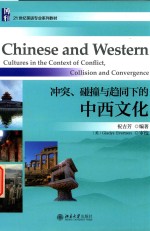
Foreword 1
Part Ⅰ East and West 2
Unit 1 Why Contrasting Chinese and Western Cultures? 2
Ⅰ Ancient Civilizations and Cultures 2
Ⅱ Cross-cultural Comparative Studies in China 4
Ⅲ Imperatives for Contrasting Chinese and Western Cultures 7
Ⅳ Key Concepts 11
Unit 2 Traditional Characteristics of Chinese and Western Cultures 14
Ⅰ “There Are All Kinds of Birds When a Forest Gets Large” 15
Ⅱ Traditional Chinese Cultural Characteristics 17
Ⅲ Traditional Western Cultural Characteristics 24
Unit 3 Affinities Across Cultures 29
Ⅰ An Unexpected Affinity 30
Ⅱ Reading for More Cultural Affinities 30
Ⅲ Key Concepts 38
Part Ⅱ Cultural Differences in Silent Languages 43
Unit 4 Time 43
Ⅰ Time in China and the West 44
Ⅱ Two Time Modes 48
Ⅲ Past-oriented Societies vs.Future-oriented Societies 54
Ⅳ Two Time Orientations 57
Unit 5 Space 61
Ⅰ Spatial Language 62
Ⅱ Spatial Language and Culture 65
Ⅲ Spatial Language and Life 71
Ⅳ Changes We Cannot Afford 73
Unit 6 Smiles,Nods and Silence 75
Ⅰ Smiles 75
Ⅱ Nods 80
Ⅲ Silence 82
Part Ⅲ Cultural Differences in Thinking 89
Unit 7 Intuitive vs.Logical Thinking 89
Ⅰ Definitions of Intuitive and Logical Thinking 89
Ⅱ Philosophy and Thinking 90
Ⅲ Application of Two Thinking Modes 94
Ⅳ Impact of Thinking Modes on Writings 98
Ⅴ Logic in China and Intuition in the West 100
Unit 8 Dialectical vs.Analytical Reasoning 104
Ⅰ Proverb Preferences Across Cultures 104
Ⅱ Dialectical Reasoning 105
Ⅲ Analytical Reasoning 109
Ⅳ More About Two Reasoning Modes 113
Unit 9 Holistic vs.Atomistic Visions 116
Ⅰ A Detention Room Incident 116
Ⅱ Prominent Attributes of Holistic and Atomistic Visions 117
Ⅲ Vision and Cognition 122
Ⅳ Vision and Language 123
Ⅴ Zhengshan Xiaozhong and Lipton Black Tea 128
Unit 10 Categorizing Objects by Relationships vs.by Attributes 131
Ⅰ Two Ways to Categorize One Person 132
Ⅱ Principles to Categorize Objects 133
Ⅲ How to Categorize Objects and Why 135
Ⅳ Impacts of Different Ways of Categorization 137
Ⅴ Causal Attribution Differences Arising out of Different Categorization Ways 140
Unit 11 Non-controllers vs.Controllers 143
Ⅰ Too Early to Tell 144
Ⅱ Why So Different Stances Towards Life? 144
Ⅲ “Being”and“Doing”Cultures 149
Ⅳ Manifestations of“Being”Culture and“Doing”Culture 153
Part Ⅳ Different Cultural Orientations 160
Unit 12 The Introvert-oriented vs.the Extrovert-oriented 160
Ⅰ Personality Types 160
Ⅱ Personality Types of Cultures 162
Ⅲ Effects of Personality Types on Pattern Preferences 166
Ⅳ A Contrast of Cultural Phenomena 171
Ⅴ The Trend of the Introvert-oriented Culture 175
Unit 13 Collectivism vs.Individualism 177
Ⅰ An Embarrassing Habit 177
Ⅱ Collectivism and Individualism as Cultural Orientations 179
Ⅲ Collectivism and Individualism in Cultural Anthropology 183
Ⅳ Collectivist and Individualist Perspectives of“Self” 185
Ⅴ Interdependence vs.Independence 189
Unit 14 Femininity vs.Masculinity 193
Ⅰ Gender Traits 193
Ⅱ Feminine Chinese Culture 195
Ⅲ Masculine Western Culture 201
Ⅳ Why So Different? 205
Ⅴ The Trend of Cultures and Its Potential Impact 208
Unit 15 Advocacy of Jing vs.Dong 211
Ⅰ Introduction to Two Concepts 211
Ⅱ Jing Advocacy of China 213
Ⅲ Dong Advocacy of the West 221
Ⅳ Differences and Discomforts 225
Unit 16 Implicitness vs.Explicitness 229
Ⅰ “Half a Story” 229
Ⅱ Implicitness and Explicitness of Language 231
Ⅲ Implicit Chinese 234
Ⅳ Explicit Westerners 241
Ⅴ High Context vs.Low Context 244
Ⅵ “Chicken and Duck Talk” 247
Part Ⅴ Different Cultural Standards 253
Unit 17 Peace vs.Conflict 253
Ⅰ Great Names and Different Cultural Standards 253
Ⅱ External Factors and Cultural Standards 258
Ⅲ Cultural Standards and Their Unique Products 260
Ⅳ Better Ways to Know Each Other 265
Unit 18 Egalitarian and Inegalitarian Distribution 268
Ⅰ Hate-the-rich Mentality 268
Ⅱ Chinese-style Egalitarianism 269
Ⅲ Western-style Inegalitarianism 272
Ⅳ Egalitarianism and Inegalitarianism in China and the West 274
Unit 19 Good vs.Evil Human Nature 279
Ⅰ Key Concepts 280
Ⅱ Human Nature and Education 281
Ⅲ Theorization of Assumptions About Human Nature 283
Ⅳ Human Nature Theories and the Rule of Ethics vs.Law 288
Unit 20 Rule of Individuals vs.Rule of Law 290
Ⅰ An Unexpected Complaint 290
Ⅱ Rule of Individuals in Traditional Chinese Thought 291
Ⅲ Rule of Law in Western Thought 296
Ⅳ Rule of Law in China 300
Bibliography 305
- 《幻想之眼 一个教育者的内在冲突》张文质著 2016
- 《我们内心的冲突》(美)卡伦·霍尼著 2018
- 《从儒家之(经权辩证)论道德冲突问题》萧美龄著 2015
- 《特殊教育学校教师工作 生活冲突研究》张俊玲著 2019
- 《民族冲突及应对研究 以吉尔吉斯斯坦南部民族冲突为例》(中国)蒋海蛟 2019
- 《工程项目冲突管理》唐冰松著 2019
- 《古典碰撞流行》温全编著 2019
- 《我们内心的冲突》(美)卡伦·霍尼著;江月译 2019
- 《碰撞与汇通》陈畏著 2016
- 《自由与国家的冲突》谭杰,李先敏,毛兴贵著 2016
- 《市政工程基础》杨岚编著 2009
- 《家畜百宝 猪、牛、羊、鸡的综合利用》山西省商业厅组织技术处编著 1959
- 《《道德经》200句》崇贤书院编著 2018
- 《高级英语阅读与听说教程》刘秀梅编著 2019
- 《计算机网络与通信基础》谢雨飞,田启川编著 2019
- 《看图自学吉他弹唱教程》陈飞编著 2019
- 《法语词汇认知联想记忆法》刘莲编著 2020
- 《培智学校义务教育实验教科书教师教学用书 生活适应 二年级 上》人民教育出版社,课程教材研究所,特殊教育课程教材研究中心编著 2019
- 《国家社科基金项目申报规范 技巧与案例 第3版 2020》文传浩,夏宇编著 2019
- 《流体力学》张扬军,彭杰,诸葛伟林编著 2019
